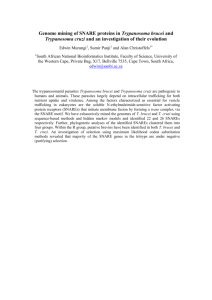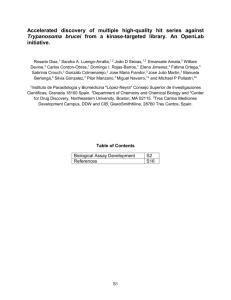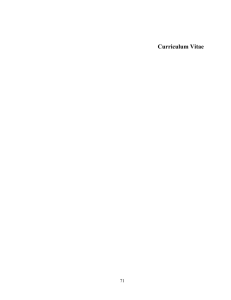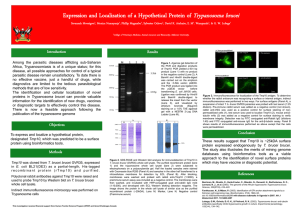Document 14092817
advertisement
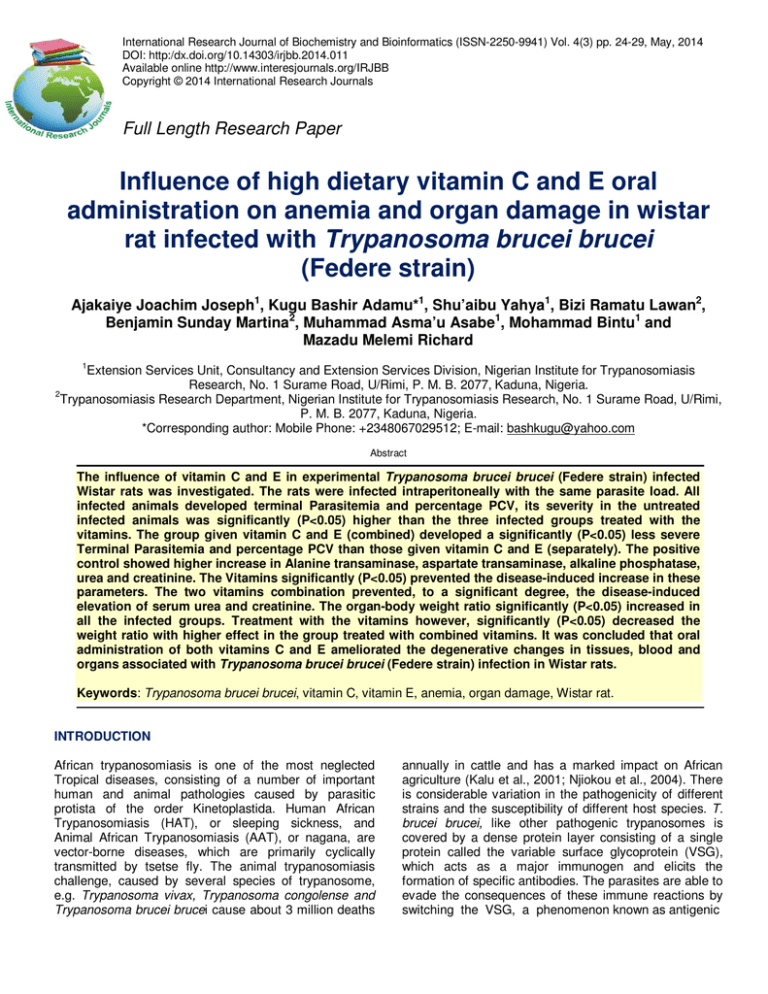
International Research Journal of Biochemistry and Bioinformatics (ISSN-2250-9941) Vol. 4(3) pp. 24-29, May, 2014 DOI: http:/dx.doi.org/10.14303/irjbb.2014.011 Available online http://www.interesjournals.org/IRJBB Copyright © 2014 International Research Journals Full Length Research Paper Influence of high dietary vitamin C and E oral administration on anemia and organ damage in wistar rat infected with Trypanosoma brucei brucei (Federe strain) Ajakaiye Joachim Joseph1, Kugu Bashir Adamu*1, Shu’aibu Yahya1, Bizi Ramatu Lawan2, Benjamin Sunday Martina2, Muhammad Asma’u Asabe1, Mohammad Bintu1 and Mazadu Melemi Richard 1 Extension Services Unit, Consultancy and Extension Services Division, Nigerian Institute for Trypanosomiasis Research, No. 1 Surame Road, U/Rimi, P. M. B. 2077, Kaduna, Nigeria. 2 Trypanosomiasis Research Department, Nigerian Institute for Trypanosomiasis Research, No. 1 Surame Road, U/Rimi, P. M. B. 2077, Kaduna, Nigeria. *Corresponding author: Mobile Phone: +2348067029512; E-mail: bashkugu@yahoo.com Abstract The influence of vitamin C and E in experimental Trypanosoma brucei brucei (Federe strain) infected Wistar rats was investigated. The rats were infected intraperitoneally with the same parasite load. All infected animals developed terminal Parasitemia and percentage PCV, its severity in the untreated infected animals was significantly (P<0.05) higher than the three infected groups treated with the vitamins. The group given vitamin C and E (combined) developed a significantly (P<0.05) less severe Terminal Parasitemia and percentage PCV than those given vitamin C and E (separately). The positive control showed higher increase in Alanine transaminase, aspartate transaminase, alkaline phosphatase, urea and creatinine. The Vitamins significantly (P<0.05) prevented the disease-induced increase in these parameters. The two vitamins combination prevented, to a significant degree, the disease-induced elevation of serum urea and creatinine. The organ-body weight ratio significantly (P<0.05) increased in all the infected groups. Treatment with the vitamins however, significantly (P<0.05) decreased the weight ratio with higher effect in the group treated with combined vitamins. It was concluded that oral administration of both vitamins C and E ameliorated the degenerative changes in tissues, blood and organs associated with Trypanosoma brucei brucei (Federe strain) infection in Wistar rats. Keywords: Trypanosoma brucei brucei, vitamin C, vitamin E, anemia, organ damage, Wistar rat. INTRODUCTION African trypanosomiasis is one of the most neglected Tropical diseases, consisting of a number of important human and animal pathologies caused by parasitic protista of the order Kinetoplastida. Human African Trypanosomiasis (HAT), or sleeping sickness, and Animal African Trypanosomiasis (AAT), or nagana, are vector-borne diseases, which are primarily cyclically transmitted by tsetse fly. The animal trypanosomiasis challenge, caused by several species of trypanosome, e.g. Trypanosoma vivax, Trypanosoma congolense and Trypanosoma brucei brucei cause about 3 million deaths annually in cattle and has a marked impact on African agriculture (Kalu et al., 2001; Njiokou et al., 2004). There is considerable variation in the pathogenicity of different strains and the susceptibility of different host species. T. brucei brucei, like other pathogenic trypanosomes is covered by a dense protein layer consisting of a single protein called the variable surface glycoprotein (VSG), which acts as a major immunogen and elicits the formation of specific antibodies. The parasites are able to evade the consequences of these immune reactions by switching the VSG, a phenomenon known as antigenic Ajakaiye et al. 25 variation (Damian, 1997). The hematological and biochemical abnormalities induced by trypanosomes arose from their direct effect via their products on host cells such as red blood cell (RBC), white blood cell (WBC), platelets and tissues such as liver, kidney, bone marrow and lymphoid organs, resulting in cell destruction and organ malfunction as well as extractions from and additions to host chemistry associated with parasite metabolism (Anosa, 1988; Ekanem and Yusuf 2008; Akanji et al., 2009). The oxidative stress which occurs in trypanosomiasis host is as a result of systematic ascorbic acid depletion due to increased ascorbic acid consumption in infected animals; this oxidative stress leads to peroxidative tissue damage, which elevates erythrocyte free radicals, oxidative haemolysis and depletion of erythrocyte and liver glutathione by free radicals generated by the trypanosome. As a result membrane Phospholipids and Proteins are attacked leading to alteration in membrane structure, which also affects the membrane fluidity. Vitamin C (Ascorbic acid) is a water-soluble antioxidant capable of protecting against oxidative injuries in the aqueous compartments of cell membrane while Vitamin E is a fat-soluble compound comprising tocopherols and tocotrienols (Brigelius-Flohe, 1999). As a fat-soluble antioxidant, it stops the production of reactive oxygen species (e.g. Oxygen ion and peroxides) formed when fat undergoes oxidation (Packer, 2001; Devasagayam et al; 2004). This work was carried out to investigate the Influence of High Dietary Vitamin C and E Oral administration on Anemia and Organ damage in Wistar Rats infected with Trypanosoma brucei brucei (Federe strain). MATERIALS AND METHODS Experimental site The study was conducted at the Nigerian Institute for Trypanosomiasis and (Onchocerciasis) Research (NITR), and located in Kaduna North Local Government Area of Kaduna State, at latitude 10° 30´ 00´´ N and longitude 7° 25´ 50´´ E of Nigeria. Experimental animals Twenty five Albino Wistar rats purchased from the rat colony of NITR, Kaduna, were used as subjects for the experiment. They were randomly divided into five groups (A, B, C, D and E) of five rats each, in well ventilated plastic cages with a 15×22×10 m3 dimension equipped with wire mesh lids. The rats were acclimatised for two weeks and duly dewormed with standard drugs before commencement of the experiment. Group A was neither treated nor infected (positive control), group B was intraperitoneally infected with 1 × 106 innoculum containing T. brucei brucei (Federe strain) parasites only (negative control), while groups C, D and E were given the same dose of innoculum and in addition they were treated orally with 150 mg/kg body weight of vitamin C; 150 mg/kg body weight of vitamin E and the combination of 150 mg/kg body weight each of vitamins C and E, respectively. Vitamins C and E were products of a commercial company (VMD, n.v./S.A, Arendonk, Belgium) and were obtained from a Veterinary commercial outlet in Kaduna, Nigeria. The animals were fed with a basal diet obtained from a commercial feed outlet (Vital Feeds Plc., Kaduna, Nigeria) and water was given ad libitum. The rats had average weight of 200 – 240 g at the commencement of the experiment. Feed constituents and calculated bromatological analyses of the basal diet are as shown in Table 1. The basal diet contain 11.50 MJ/Kg of metabolisable energy (ME), 16.50 g of crude protein (CP), 5.50 g of calcium and 1.45 g of available phosphorus, calculated to be slightly above the nutrient requirement recommended for laboratory animals (NRC, 1995). (a) Vitamin supplement per (kg) diet: Vitamin A, 6000 IU, vitamin D3, 5000 IU, vitamin E; 23.0 mg; vitamin k3, 4.0 mg; thymine, 11.0 mg; riboflavin, 4.0 mg; vitamin B12, 0.005 mg; pyridoxine, 1.8 mg; pantothenic acid, 20,0 mg; nicotinic acid, 35 mg; folic acid, 2.5 mg; choline chloride, 615 (b) Mineral supplement (mg/kg diet): Cobalt, 0.40 mg; iron, 130 mg; copper, 5 mg; zinc, 18 mg; iodine, 1.55 mg. Inoculation of rats with parasite The parasites T. brucei brucei (Federe strain) was obtained from the stabilates kept in Vector and Parasitology Department of NITR, Kaduna, Nigeria. The parasite was inoculated into a clean rat which serves as donor rat. Infected blood from a donor rat at peak parasitaemia, that is, 4 days post infection (DPI) was collected by means of tail picking and diluted with cold physiological saline. The number of parasite in the diluted blood was determined through the method described by Herbert and Lumsden (1976), and a volume containing approximately 1× 106 parasites was injected intraperitoneally into each rat in the infected groups. Blood Sample collection, organs collection and Serum Analysis Tail blood was collected daily for monitoring parasitemia as described by Herbert and Lumsden (1976) and PCV by the micro-haematocrit method. On 28 DPI, the rats were sacrificed by humane decapitation prior anesthesia with sterile cotton impregnated chloroform, and blood was collected in plain vacutainers, serum was harvested and used for estimation of alanine amino-transferase 26 Int. Res. J. Biochem. Bioinform. Table 1. Composition and calculated bromatological analysis of basal diet Nutrients/constituents Maize Soya cake Wheat offal Fishmeal Brewer’s dried grain Vegetables oil Limestone Monocalcium phosphate Dry molasses Sodium chloride Pre-mix Vitamins(a) and Minerals(b) Quantity in g/kg diet 480.0 175.0 160.0 100.0 20.0 25.0 5.0 10.5 15.0 5.0 2.5 Calculated analysis /Kg ME, MJ /kg CP, g Lysine Methionine +Cystine, g Tryptophan, g Threonine, g Ca, g P (a), g Na, g CI, g 11.50 16.50 1.65 0.92 0.20 0.61 5.50 1.45 0.50 0.50 Source: Dale and Batal (2006). Table 2. Serum chemistry of Wistar rats infected with T. brucei brucei (Federe strain) and administered with vitamins C and E (Means ± SEM, n = 5) ALT Not infected not treated 19.80±0.68C AST 31.70±0.78 42.90± 0.94 36.90± 1.01 36.70± 1.13 35.40± 1.10 ALP 78.40±0.67C 211.20±0.70B 228.30±1.67A 230.10±2.52A 229.70±1.19A UREA 174.50±2.01B 319.30±2.79A 149.80±0.83C 147.50±0.92C 145.20±0.76C CREATININE 59.40± 0.56 D 106.00± 1.9A 63.80± 0.63C 67.60± 1.02B 61.70±0.94CD C Infected not treated 32.20± 0.70A A Infected + Vit. C Infected + Vit. E 31.40± 0.31A 30.30±0.63AB B B Infected + Vit. C and E 28.50± 0.85B B Values with different superscripts within a row are statistically different (P<0.05) (ALT), aspartate amino-transferase (AST) and alkaline phosphatase (ALP) activities using the method described by Bergmeyer et al. (1978) with the aid of commercial reagent kit (Gasellch aft fur Biochemica und Diagnostica, Wiesbgden, Germany).The serum samples were also used for the estimation of Urea and Creatinine by the Diacetylmonoxime and Jaffe’s reactions, respectively as described by Kaplan et al. (1988). Organs were removed aseptically from all the groups and kept in 10 % buffered formalin. Statistical Analysis All the datas obtained from this experiment are presented as mean ± SEM. Data were analyzed by the one-way analysis of variance (ANOVA) and the significance of differences between mean values computed for particular levels of experimental factors was determined by (Duncan, 1955) post-hoc test and means that differs at p < 0.05 were considered significant. RESULTS Table 2 presents the result of the serum biochemical indicators in this experiment. Infected groups showed significant (P<0.05) increase in the levels of ALT, AST, ALP and creatinine when compared to the uninfected group. Group II showed significant (P<0.05) increase in Ajakaiye et al. 27 Table 3. Organ: body weight ratios of Wistar rats infected with T. brucei brucei (Federe strain) and administered with vitamins C and E (Means ± SEM, n = 5) HEART Not infected not treated 1.47± 0.24C Infected not treated 3.18± 0.23 A Infected + Vit. C Infected + Vit. E 1.87± 0.08 B 1.79± 0.06 BC Infected + Vit. C and E 1.63± 0.05 BC LIVER 3.10± 0.00 C 4.82± 0.11 A 3.43± 0.08 B 3.44± 0.10 B SPLEEN 0.59± 0.04 E 2.13± 0.04 A 1.71± 0.02 C 1.83± 0.02 B 1.27± 0.20 D KIDNEY 0.83± 0.01 B 1.06± 0.03 A 0.7± 0.02 B 0.73± 0.01 C C 0.80± 0.01 3.30± 0.06 BC Values with different superscripts within a row are statistically different (P<0.05) Table 4. Terminal Parasitemia and % change in PCV of Wistar rats infected with T. brucei brucei (Federe strain) administered with vitamins C and E (Means ± SEM, n = 5) and Not infected not treated Infected not treated 152.30±1.22A Infected + Vit. C Infected + Vit. E 102.20±2.99B 101.90±2.63B Infected + Vit. C and E 82.50±0.73C Initial PCV (%) 48.90±1.12 48.90± 1.03 48.60± 1.2 48.70± 1.13 49.00± 1.22 Final PCV (%) 49.20±1.14 29.20± 0.95 40.50± 1.60 39.70± 1.97 44.10± 1.27 (+)30±1.78 (-)19.70±1.09 (-)8.10± 1.35 (-)9.00± 2.04 (-)4.90±1.92 Terminal parasitemia % change PCV* in * Values with different superscripts within a row are statistically different (P<0.05). Positive signs (+) indicates increases and negative signs (-) indicates decreases. urea level and significant (P<0.05) lower level in treated groups in comparison with uninfected untreated group. Values recorded for AST, ALT, Urea and Creatinine were significantly (P<0.05) higher in group II when compared to the vitamins treated groups, while ALP showed related pattern but in an opposite direction. Table 3 present the result of the organ body weight ratio, which significantly (P<0.05) shows increase in organ-body weight ratio of the heart, liver and spleen in all the infected groups when compared to the negative control. However, there was no significant (P>0.05) difference observed in the organ body weight ratio of the kidney in group IV whereas a significant decrease (P<0.05) was observed in groups III and V when compared to the negative control. In Table 4, The Parasitemia of groups III, IV and V were significantly (P<0.05) lower than group II and among the infected and treated groups, group V showed least level of parasitemia. In the same Table, infected groups developed anaemia as observed in the downward displacement of their PCV profiles in comparison to the uninfected group. Nevertheless, there was a significant (P<0.05) increase in final PCV of the treated groups when compared to infected untreated group. DISCUSSION In this experiment, there is Increase in levels of Alanine amino-transaminase(ALT), aspartate aminotransaminase(AST), alkaline phosphatase(ALP), urea and Creatinine due to infection. This agrees with the findings of Hudson (1944), Kalu et al. (1989), Adah et al. (1992), Ismaila et al. (2000) and Umar et al. (2008) who reported increase in serum levels in experimental trypanosomiasis. Increases in the levels of these enzymes are indications of damage to liver, brain, and cardiac muscles (Kaplan, 1988) and several workers have reported hepatocellular damage and generalized degenerative changes in other tissues and organs in trypanosomiasis (Anosa et al., 1984; Bruijn, 1987). The decrease observed in the levels of ALT, AST, ALP, Creatine and Urea in the treated groups might be as a result of Vitamins C and E supplementation. The enlargement of the organs (Heart, Liver, Kidney and Spleen) Otherwise known as cardiomegaly, Hepatomegaly and Splenomegaly respectively as observed in the result, is presumably due to membrane damage caused by the large amount of free radicals and other oxidative species being generated and the 28 Int. Res. J. Biochem. Bioinform. concomitant reduction in systemic antioxidant reserves. This agrees with the findings of Morrison et al. (1978) who reported Hepatomegaly and Splenomegaly in trypanosomiasis. The increase in size of liver and spleen is caused by the activation of the immune system during trypanosome infection. The prevention of organ damage by vitamins C and E is predicated on its antioxidant activity (Anderson and Theron, 1990). Spleen is involved in producing antibodies that fight infection and as a result of this intense activity the organ is enlarged. The kidney serves many important functions, among are: Filtering out wastes to be excreted in the urine and Stimulating red blood cell production via the release of the hormone erythropoietin. For this reason, it tends to increase in size so as to meet the needs of the infected animals. It was earlier reported that infection of trypanosome causes anemia (Igbokwe and Nwosu 1997), this mean that there is no enough red blood cell to carry adequate oxygen to the tissues. If the anemia becomes chronic, it will lead to rapid or irregular heartbeat, in this case, the heart must pump more blood to make up for the lack of oxygen in the blood. For this reason, the heart tends to enlarge above normal, since the animal is untreated. The change in PCV is an indicator which gives the disease status and productive performance of T. brucei brucei infection. Trypanosome infection caused anaemia in both treated and untreated groups as a result of massive erythrophagocytosis by an expanded and active mononuclear phagocytic system (MPS) of the host (Igbokwe and Nwosu, 1997). The low final-percentage PCV observed in the infected groups may be as a result of acute hemolysis due to growing infection, this result agrees with earlier studies by Anosa (1988) and Igbokwe et al. (1994). Unlike the untreated group, the groups treated with vitamins C and E show significant (p<0.05) percentage increase in the PCV, this virtually means the vitamins have ameliorated the effect of the trypanosome infection on the PCV values. Previous studies have shown that infection with trypanosomes resulted in increased susceptibility of red blood cell membrane to oxidative damage probably as a result of depletion of vitamins on the surface of the red blood cell (Igbokwe et al., 1994, 1996; Taiwo et al., 2003; Akanji et al., 2009). Severity of anaemia usually reflects the intensity and duration of parasitaemia, this corroborates with several reports by Ogunsanmi et al. (2001), Umar et al. (2007) and Saleh et al. (2009) who attributed acute anaemia in trypanosomiasis to rapidly increase Parasitemia. CONCLUSION The vitamins C and E aided in reducing the free radicals being generated by the Trypanosoma brucei brucei (Federe strain), ameliorated anemia and organ damage. Nevertheless, the combined administration of vitamins was more effective than single administration. The data lend further support to the significant roles of oxidative stress and depletion of endogenous antioxidant reserves in the organ pathogenesis of African trypanosomiasis. REFERENCES Adah MI, Otesile EB, Joshua RA (1992). Changes in levels of transaminases in goats experimentally infected with Trypanosoma congolense. Rev. Elev. Med. Pays Trop. 45: 284-286. Akanji MA, Adeyemi OS, Oguntoye SO, Sulyman F (2009). Psidium guajava extract reduces trypanosomosis associated lipid peroxidation and raises glutathione concentrations in infected animals. EXCLI J. 8: 148-154. Anderson R, Theron AJ (1990). Antioxidant and tissue protective function of ascorbic acid. In: World Review of Nutrition and Dietetics. 62, eds. by Borne GH, Kruger S, N.Y. pp. 37-38. Anosa VO (1988). Hematological and Biochemical changes. In: Revue d’Elerage et de Medicine veterinare d pays Tropicans (in french). 41-164. Anosa VO, Kaneko JJ (1984). Pathogenesis of T brucei infection in deer mice (P. maniculatus). Ultra structural pathology of the spleen, liver, heart and kidney. Vet. Pathol. 21: 229-237. Bergmeyer HU, Scheibe P, Wahlefeld AH (1978). Optimisation methods for aspartate aminotransferase and alanine aminotransferase. Clin. Chem. 24: 58-73. Brigelius-Flohe BT (1999). Vitamin E: function and metabolism. FASEB 13: 1145–1155. Bruijn JA, Oemar BS, Ehrick HH, Foidart JM, Flueures GJ (1987). Antibasement membrane glomerulopathy in experimental trypanosomiasis. J. Immunol. 139: 2482- 2485. Dale N, Batal DA (2006). Feedstuffs ingredients analysis table. In: 2006 eds. University of Georgia, Athens, GA. Damian RT (1997). Parasite immune evasion and exploitation: Reflections and projections. Parasitol. 115: 169-175. Devasagayam TPA, Tilak JC, Boloor KK, Sane KS, Ghaskadbi SS, Lele RD (2004). Free Radicals and Antioxidants in Human Health: Current Status and Future Prospects. Journal of Association of Physicians of India. (JAPI) 52: 796. Duncan DB (1955). Multiple range and multiple F test. Biometrix. 11: 142. Ekanem JT, Yusuf OK (2008). Some biochemical and hematological effects of black seed (Nigella sativa) oil on T. brucei-infected rats. Afr. J. Biomed. Res .11:79–85. Herbert WJ, Lumsden WHR (1976). Trypanosoma brucei: A rapid “matching” method for estimating the host’s parasitemia. Exptl. Parasitol. 40: 427-431. Hudson JR (1944). Acute and sub-acute trypanosomosis in cattle caused by T. vivax. J. Comp. Pathol. 54:108–119. Igbokwe IO, Esievo KA, Saror DI, Obagaiye OK (1994). Increased susceptibility of erythrocytes to in vitro peroxidation in acute Trypanosoma brucei infection in mice. Vet. Parasitol. 55: 279-286. Igbokwe IO, Nwosu CO (1997). Lack of correlation of anaemia with splenomegaly and hepatomegaly in Trypanosoma brucei and Trypanosoma congolense infections of rats. J. Comp. Pathol. 117: 261-265. Igbokwe IO, Umar IA, Omage JJ, Ibrahim NDG, Kadima KB, Obagaiye OK, Saror DI, Esievo KAN (1996). Effect of acute Trypanosoma vivax infection on cattle erythrocyte glutathione and susceptibility to in vitro peroxidation. Vet. Parasitol. 63: 215-224. Ismaila AU, Zipporah AT, Funnilayo II, Abubakar G. Lawan BB (2000). The Role of Vitamin C Administration in Alleviation of Organ Damage in Rats Infected with Trypanosoma brucei. J. Clin. Biochem. Nutr. 28: 1-7. Njiokou F, Simo G, Nkinin SW, Laveissiere C, Herder S (2004). Infection rate of Trypanosoma brucei s.l., T. vivax, T. congolense “forest type”, and T. simiae in small wild vertebrates in south Cameroon. Acta Trop. 92: 139–146. Kalu AU, Ikwuegbu OA, Ogbonnah GA (1989). Serum protein and electrolyte levels during trypanosome infection and following Ajakaiye et al. 29 treatment in the West African Dwarf goats. Bull. Anim. Heal. Prod. Afr. 37: 41-45. Kalu AU, Oboegbulem SI, Uzoukwu M (2001). Trypanosomiasis in small ruminants maintained by low riverine tsetse population in central Nigeria. Small Rumin. Res. 40: 109–115. Kaplan LA, Szabo LL, Opherin EK (1988). Enzymes in clinical rd chemistry: Interpretation and Techniques. 3 eds. Lea and Febliger, Philadelphia. pp. 182 – 184. Morrison WI, Murray M, Sayer PD (1978). Pathogenesis of tissue lesions in T. brucei infections. In: pathogenicity of trypanosomes. Proceedings of a workshop held in Nairobi, Kenya, eds. Losos G, Chouinard A, IDRC, Ottawa. pp. 171-177. th NRC (1995). Nutrient requirements of laboratory Animals. 4 (Ed) National Academy press, Washington DC, USA. pp.11-16. Ogunsanmi AO, Taiwo VO (2001). Pathobiochemical mechanisms involved in the control of the disease caused by Trypanosoma congolense in African grey duiker (Sylvicapra grimmia). Vet. Parasitol. 96: 51–63. Packer L, Weber SU, Rimbach G (2001). Molecular aspects of αtocotrienol antioxidant action and cell signalling. J. Nutri. 131(2). Saleh MA, Bassam MA, Sanousi SA (2009). Oxidative stress in blood of camels (Camelus dromedaries) naturally infected with Trypanosoma evansi. Vet. Parasitol.162: 192–199. Taiwo VO, Olaniyi MO, Ogunsanmi AO (2003). Comparative plasma biochemical changes and susceptibility of erythrocytes to in vitro peroxidation during experimental Trypanosome congolense and T. brucei infections in sheep. Israel. J. Vet. Med. 58(4). Umar I A, Rumah BL, Bulus SL, Kamla AA, Jobin A, Asueliman BI, Mazai MH, Ibrahim MA, Isah S (2008): Effects of intraperitoneal administration of vitamins C and E or A and E combinations on the severity of Trypanosoma brucei brucei infection in rats. Afri. J. Biochem. Res. 2 (3): 088-091 Umar IA, Ogenyi E, Okodaso D, Kimeng E, Stancheva GI, Omage JJ, Isah S, Ibrahim MA (2007). Amelioration of anaemia and organ damage by combined intraperitoneal administration of vitamins A and C to Trypanosoma brucei brucei-infected rats. Afr. J. Biotechnol. 6: 2083–2086. How to cite this article: Ajakaiye J.J., Kugu B.A., Shu’aibu Y., Bizi R.L., Benjamin S.M., Muhammad A.A., Mohammad B. and Mazadu M.R. (2014). Influence of high dietary vitamin C and E oral administration on anemia and organ damage in wistar rat infected with Trypanosoma brucei brucei (Federe strain). Int. Res. J. Biochem. Bioinform. 4(3):24-29
